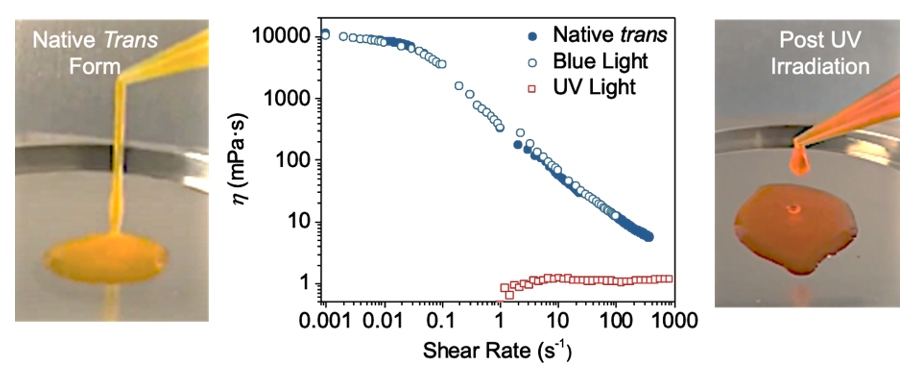Smart viscoelastic fluids, whose flow behaviour can be changed on demand, have the potential to be innovative in areas such as controlled flow and release, microfluidic device technology, drag reduction and efficient heating and cooling. The “smart” control is incorporated by use of a surfactant or additive that responds to a stimulus, such as light.
Here, we demonstrate a simple, smart viscoelastic fluid that shows light-controllable viscosity. Unlike most approaches to creating light-responsive fluids, which rely on additives and salts, this system has only one component: an azobenzene-based surfactant, at a relatively low concentration (2.5 wt%). This photosurfactant can photoisomerise between trans- and cis-dominant states upon irradiation with blue or UV light, respectively. Photoisomerisation leads to a change in the shape and polarity of the individual surfactant molecules, which in turn influences their self-assembly behaviour. In the trans-dominant state, the photosurfactant solution is viscous and viscoelastic, transforming to a non-viscous, Newtonian fluid upon UV irradiation. The difference in viscosity between these two states is over 4 orders of magnitude. This viscosity change can also be reversed and repeated, through alternating blue and UV light irradiation. Structural characterisation by small-angle x-ray scattering and cryo-transmission electron microscopy reveal that the photosurfactant forms a highly entangled network of wormlike micelles in the high-viscosity state. Upon UV irradiation, long cylindrical micelles remain, but the entanglement of the micellar network is greatly reduced.
This study demonstrates that complicated, multi-component formulations are not needed to create smart viscoelastic fluids, with the only requirement here being that the fluid absorbs light. We also show that merely tuning the degree of entanglement of the self-assembled network is sufficient to create dramatic differences in viscosity, the magnitude of which (4 orders) is significant enough to act as a switch between ‘on’ and ‘off’ states for flow.
Figure: A simple, single-component light responsive fluid comprised of a neutral photosurfactant in water can reversibly switch its viscosity by four orders of magnitude, between a viscous, viscoelastic state and a low viscosity, watery state, depending on the wavelength of light used.
Elaine A. Kelly, Niamh Willis-Fox, Judith E. Houston, Camille Blayo, Giorgio Divitini, Nathan Cowieson, Ronan Daly and Rachel C. Evans, "A Single-Component Photorheological Fluid with Light-Responsive Viscosity", Nanoscale, 2020, 12, 6300 – 6306. Hot Article.

